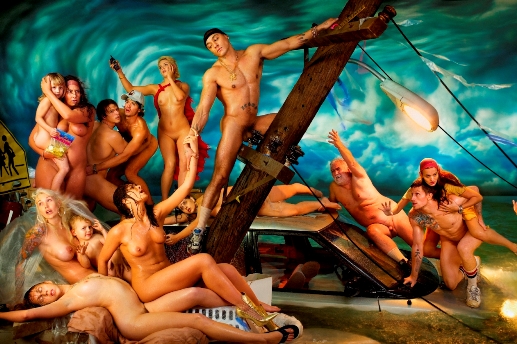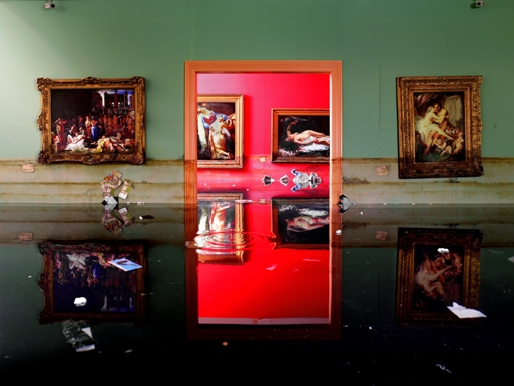
Cinematic, larger than life, teeming with detail and almost painterly in their rich, sensual color, the photographs of David LaChapelle compel the viewer’s attention. LaChapelle’s first exhibit in Israel, David LaChapelle: Postmodern Pop Photography, will open to the public at the Tel Aviv Museum of Art on Friday, July 23, 2010, with a selection of his work from the past twenty years.
Known for his fashion and celebrity photographs, LaChapelle left magazine work four years ago to pursue his personal vision, exhibiting in art galleries and museums. The extent of his dedication was demonstrated as he personally guided a group of journalists through the exhibit this past Monday for a preview tour. Cooly casual in a grey T shirt and red baseball cap, accepting the non-stop questions with equanimity, LaChapelle talked about everything from materialism to Magritte, affectionately calling the latter “one of my favorites, a crazy punk rocker.”
Even as a child he knew he wanted to be an artist, yet LaChapelle dropped out of high school, explaining that it was “because I was being harassed, I was getting beaten up. In American it’s impossible to be different.” When asked what made him different enough to become a target, LaChapelle did not hesitate to answer, “I wore crazy clothes, I was gay and they could feel that.”
Expressing both praise and criticism with a relaxed openness and spontaneity, he admires Michelangelo, Picasso, Michael Jackson and Andy Warhol, yet does not spare the Pope, saying: “When the Pope visits Africa and his first speech is about the sin of condoms – to me that’s genocide [referring to a comment made by Pope Benedict XVI en route from Rome to Yaounde in March 2009].”
Although this is the first time his work is being exhibited in Israel, it is not LaChapelle’s first visit to Israel or the Tel Aviv Museum. He spent time on a kibbutz when he was about 19, probably Sdot Yam. Of the museum he says, with disarming honesty “I was going to say I never dreamed I’d have a show here, but I did. I guess dreams come true. This museum is incredible to me.”
As he guided the group through the gallery, he discussed his work. In response to a comment on the strong colors of the current exhibit he said, “I never chose a style, I did what attracted me. In 1984 I started working in black and white, I did that for 6 years, I call them the dark ages. I was working in magazines, learning color printing. This was also the grunge period, everything was de-saturated.”

Mentioning contemporary photographers such as Bruce Weber and Peter Lindbergh, known for their black and white photography, he said, “I wanted to see the world bright. I was feeling very optimistic.” He recounted one of his experiments with color: “I took a dollar bill and put it in the enlarger and light came through it, and it came out hot pink. That was in 1990. I did it with a shekel [for the forthcoming exhibit] – it’s so psychedelic. It’s purely as a negative – there is no digital work here.” As the exhibit was not fully mounted, the photograph Chapelle referred to was still lying on the floor, carefully covered. Eager to show the journalists exactly what he meant, he lifted the foam covering to reveal the psychedelic, giant-size bill.

Of the works included in the exhibit, Deluge, a contemporary casting of the onset of the flood, is the first piece he created after quitting commercial work. Inspired by Michelangelo’s paintings of scenes from Genesis on the ceiling of the Sistine Chapel, LaChapelle sought to address “the flood of the future, as a metaphor of the end,” adding cheerfully, “We’re all going to end.” Despite the fact that many of his photographs address hard-hitting themes, his approach is very optimistic. In this case, LaChapelle drew the journalist’s attention to the fact that “everyone’s helping each other.”
Commenting on the painting, an intricate composition of nude people caught by the deluge, he said, “Photography is a different language than painting. It’s more difficult to photograph the human figure, because of the connotations of nudity as pornography. In color photographs there is the challenge of rescuing the figure from the dark ages. We’re in a new dark age. In the dark ages the body was considered sinful, in the enlightenment everyone took their clothes off.”
LaChapelle then moved to the “Awakened” series of portraits, in which he sought to depict the “moment between life and death.” He wanted the figures to project “a sort of serenity, [as if they were] unconscious of being photographed.” To achieve that feeling he photographed them immersed in water. He also explained that the clothing was carefully chosen from thrift stores, because, “we always see [photographs of] ballet underwater with flowing chiffon. I wanted them to be more pedestrian.”

The water and flood imagery and associations continue in the photograph Museum, which LaChapelle said was “created at a time when the art world was talking about prices. You can own a priceless work of art, but unless you can use it as a raft when the flood comes, it’s worthless. You can own a work of art simply go to a museum and stare at a work that you love while you’re in front of it, it’s yours.”
Addressing the possible perceived contradiction between his message of spiritual values with its criticism of over-consumption, and the celebrity images and glamorous style of the photographs, LaChapelle said: “I use beauty as a tool to get your attention. If I were to take ugly pictures no one would look at them. It’s more subversive to use beauty. I bring you in with color, glamour, beauty. I’m trying to get you to look long enough.”
On the inevitable question – yes, he has received some criticism about coming to Israel. Yet on this, as on every other issue, LaChapelle has strong opinions, saying, “If you really are an artist and you don’t come to Israel, what is that saying? I think it is an act of aggression…passive aggression. Fuck them – you don’t need them [referring to artists who boycott Israel]. Artists are the ones who are supposed to be bringing the dialogue. Something to aspire to…I love Israel and I love people and I’ve never listened to what people said about me since high school.”
David La Chapelle: Post Modern Pop Photography
Curator: Nili Goren
Markus B. Mizne Gallery, Gabrielle Rich Wing
Tel Aviv Museum of Art, 27 Shaul Hamelech Blvd
The exhibit will be open through October 23, 2010
AYELET DEKEL





